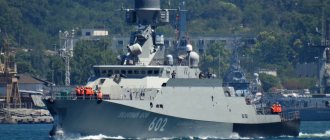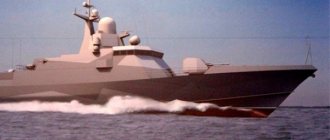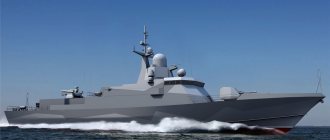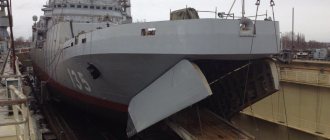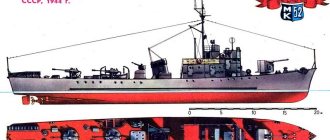In 2014, an event occurred whose importance for the Russian Navy is difficult to overestimate. To celebrate Russian Navy Day, domestic shipbuilders handed over to the sailors two new combat units - small missile ships of Project 21631 "Buyan-M", which were named in honor of the ancient Russian cities "Grad Sviyazhsk" and "Uglich". They became the first signs of a whole series of ships that Russian sailors expect to receive by 2022.
Of course, these ships with a displacement of less than one thousand tons do not inspire such respect as huge cruisers or nuclear missile carriers. But in the future they will undoubtedly play an important role in protecting the maritime borders of our Motherland.
Project 21631 is a series of small multi-purpose missile and artillery ships of the river-sea class. With a displacement of 950 tons, a shallow draft and rather low sides, it’s hard to dream of conquering the ocean spaces - the ships of the Buyan-M project were initially conceived for service in the waters of closed seas, of which there are three in Russia: Azov, Caspian and Black. Thanks to the presence of water-jet propulsion, Buyany-M are capable of operating in river mouths and in shallow seas.
They differ from their prototype - the Project 21630 artillery boat - by almost twice the displacement and the presence on board of a powerful missile system that allows them to strike at surface and ground targets.
Their main task is to protect the economic zone of the state, but the Buyanov weapons complex gives these vessels much broader capabilities. This was clearly demonstrated on October 7, 2015, when three ships of this project from the Caspian Sea launched a missile attack on targets located in Syria.
Specialists from the Zelenodolsk Design Bureau worked on the development of this project; it was supported by the 1st Central Research Institute of Moscow Region. The first ship of the Grad Sviyazhsk series was laid down at the Shipyard named after. Gorky on August 27, 2010, its launch took place at the beginning of 2013.
At the end of 2015, the fifth MRK of this series, the Serpukhov ship, was accepted into the fleet. Currently, Vyshny Volochek, the sixth RTO of this project, is undergoing state tests.
In total, thirteen Buyanov-Ms are planned to be transferred to the Russian fleet. Currently, the Shipyard named after. Gorky is building five RTOs, and a contract has already been signed between the enterprise and the Ministry of Defense for one more ship. Moreover, the last three ships of this series will have a more powerful weapon system - they are planned to be equipped with a new radar and Pantsir-SM air defense system, which will significantly increase the level of protection of the ships from threats from the air.
History of the creation of the Buyan-M MRK
The history of Project 21631 began in August 2002, when it was decided to build seven similar ships to strengthen the Caspian flotilla. A tender was announced, in which nine Russian shipbuilding enterprises took part. The winner was the Zelenodolsk plant named after. Gorky. On May 28, 2010, a contract was signed between him and the Ministry of Defense for the construction of five ships of this project.
The ship was initially developed taking into account the characteristics of the Volga delta and the Caspian Sea. The cruising range of the MRK was designed in such a way that it could make long journeys along the entire length of the river. It was planned to build up to ten ships of this project to strengthen the Caspian Flotilla and the Black Sea Fleet. Then the number 9 RTOs appeared in the media - six of which were supposed to be part of the Black Sea Fleet, and three were to go to the Caspian Sea.
The lead ship "Grad Sviyazhsk" was laid down with great fanfare on August 27, 2010, and a year later, with an interval of one month, the construction of two small missile ships began at once - the ships "Veliky Ustyug" and "Uglich". The first two ships of the series were launched in March 2013 and, after successful completion of mooring tests, were sent to Astrakhan, the main base of the Caspian flotilla. Having successfully passed state tests, both ships were accepted into the fleet in July 2014.
In 2012 and 2013, the ships “Green Dol”, “Serpukhov” and “Vyshny Volochek” were laid down - all of them have already been launched and accepted or are preparing to join the Russian Navy.
Currently on the stocks of the Shipyard named after. Gorky's ships "Orekhovo-Zuevo", "Ingushetia", "Grayvoron" and "Naro-Fominsk" are in varying degrees of readiness. It is planned that all of them will be part of various Russian fleets by 2022.
In 2014, after the adoption of anti-Russian sanctions, the German company MTU refused to supply engines for new ships of the Buyan-M project. However, this did not become a disaster for the project - a replacement was found quite quickly. For the next Buyanov-M, the power plant will be manufactured in Russia, most likely using Chinese components. In this regard, the St. Petersburg and OJSC Kolomensky Plants are most often named.
In 2016, a contract was signed between the Russian military department and shipbuilders for the construction of three additional ships of this series. Moreover, some changes will be made to the composition of their weapons. It is possible that the construction of this type of MRK will continue and in the future they will be part of other fleets, for example, the Northern or Pacific.
Small missile ship "Grad Sviyazhsk" project 21631 (code "Buyan-M") Russian Navy
| MRK "Grad Sviyazhsk" during exercises | "Grad Sviyazhsk" leaves the Baku port | MRK "Joshan" (P 225) and "Grad Sviyazhsk" |
| RTO "Grad Sviyazhsk" arrived in Baku | MRK "Grad Sviyazhsk", tail number 652 | "Grad Sviyazhsk" in the Caspian Sea |
| Ship "G-124" and MRK "Grad Sviyazhsk" | "Grad Sviyazhsk", Caspian Sea | MRK "Grad Sviyazhsk" and "Uglich" |
| The newest RTOs perform artillery firing | "Grad Sviyazhsk" during testing | MRK "Grad Sviyazhsk" begins sea trials |
| Small rocket ship of the Buyan-M project | Small rocket ship "Grad Sviyazhsk" | MRK "Grad Sviyazhsk" |
The small rocket ship "Grad Sviyazhsk" is the lead serial ship of Project 21631 (code "Buyan-M"), which is being built at JSC Zelenodolsk Plant named after. A.M. Gorky" commissioned by the Russian Navy.
On May 17, 2010, the Zelenodolsk Shipyard won the tender for the construction of Project 21631 ships, in which nine shipbuilding enterprises participated. And on May 28, 2010, a contract was signed for the construction of ships of this series.
Small missile ships of Project 21631 (code "Buyan-M") are multi-purpose ships of the "river-sea" class.
Project 21631 was developed by the Zelenodolsk Design Bureau for the Russian Navy, the first chief designer of the project is Ovsienko. The purpose of small missile ships of this project is to guard and protect the economic zone of the state. In total, it is planned to build from 8 to 10 ships of this project to replenish the ship composition of the Caspian Flotilla and the Russian Black Sea Fleet. They are a modernized version of Project 21630 “Buyan”, designed and built specifically for the Caspian Flotilla, taking into account the shallow depths of the Volga River and the Caspian Sea.
Their prototypes - small artillery ships "Astrakhan", "Volgodonsk" and "Makhachkala" - have proven themselves well and continue to successfully perform their intended tasks during service in the Caspian Flotilla.
Unlike their prototypes, the new buildings have a larger displacement and are equipped with modern types of artillery, missile, anti-sabotage, anti-aircraft and radio-technical weapons.
All ships of this project are equipped with the latest missile weapons - the Kalibr-NK universal long-range missile system.
When constructing the ships, so-called stealth technology was used, which makes them difficult for the enemy to detect. The architectural appearance of the ships meets the requirements for reducing radar signature (inclined flat surfaces of the superstructure, the presence of bulwarks, hidden superstructures and decks in the planes, doors and hatches).
The ship "Grad Sviyazhsk" (building number 631) was laid down on August 27, 2010 at 11:00 o'clock in the afternoon and became the first lead ship of project 21631. The ship is named after Sviyazhsk, a fortified city built by Ivan the Terrible in 1551 as a base for the siege of Kazan, now a village in the Zelenodolsk region of Tatarstan. Launched on March 09, 2013.
Main characteristics: Displacement 949 tons. Length 74.1 meters, width 11.0 meters, height 6.57 meters, draft 2.6 meters. Speed 25 knots. Cruising range up to 1500 miles. Autonomy 10 days. Crew from 29 to 36 people.
Propulsion: Water jet propulsion.
Weapons:
Artillery: 1x1 100mm AU A-190 “Universal”, 2x1 14.5mm machine gun mount, 3x1 7.62mm machine gun mount.
Anti-aircraft artillery: 2x6 30-mm ZAK Duet (AK 630-M2).
Missile armament: 1x8 Caliber or 1x8 Oniks, 2x4 3M47 Gibka launchers with Igla or Igla-M missiles.
On June 17, 2013, the Grad Sviyazhsk MRK began its transition from the city of Zelenodolsk (Republic of Tatarstan) to the Caspian Flotilla. On June 24, he arrived at the base of the Caspian Flotilla - the city of Astrakhan. On July 10, factory sea trials of the ship began.
At the beginning of August, it entered the Caspian Sea for the first time to conduct the first stage of testing - factory sea trials (FST).
On September 25, combat and sea trials of the small missile ship Grad Sviyazhsk were completed in the Caspian Sea. The commissioning team of the manufacturer from the city of Zelenodolsk, together with the crew of the small missile launchers, tested the effectiveness of artillery systems and other types of ship weapons when firing with maximum loads.
On September 27, the Grad Sviyazhsk successfully conducted its first firing at a naval target in the Caspian Sea. The shooting was carried out with a high-precision cruise missile from the modern Kalibr-NK ship-based missile system.
On April 14, 2014, it entered the Caspian Sea for testing under unfavorable hydrometeorological conditions (in a stormy sea).
On April 30, the crews of the newest small missile ships “Grad Sviyazhsk” and “Uglich” successfully completed test artillery firing at simulators of sea and air targets, which became the final stage of state testing of the new ships.
From May 05 to 08, the Grad Sviyazhsk and Uglich MRKs, along with other ships of the flotilla, took part in a bilateral test tactical exercise in the Caspian Sea.
On July 27, 2014, on Navy Day, the small missile ships Grad Sviyazhsk (board number 021) and Uglich (board number 022) were accepted into the Caspian Flotilla.
On July 29, the crews of the new small missile ships “Grad Sviyazhsk” and “Uglich” began practicing the first course task (K-1), which is the initial stage in the ship’s combat training system to carry out missions as intended with independent access to the sea.
On October 1, a detachment of ships of the Caspian flotilla, consisting of the missile ship "Dagestan" and the small missile ship "Grad Sviyazhsk", left the anchorage in the port of Makhachkala and went to sea to carry out combat service tasks.
On October 3, a detachment of ships of the Caspian flotilla, consisting of the missile ship "Dagestan" and the small missile ship "Grad Sviyazhsk", as part of the performance of military service tasks, entered the port of Aktau of the Republic of Kazakhstan on a friendly visit, which was completed on October 07.
Russian military vessels anchored in the port of Anzali, in the northern Iranian province of Gilan, in order to convey a message of peace and friendship to the Islamic Republic. The missile ships "Dagestan" and "Grad Sviyazhsk" entered the port, south of the Caspian Sea, on the morning of October 13, and will remain in the Iranian port until October 15.
On October 16, a detachment of ships of the Caspian flotilla, consisting of the missile ship "Dagestan" and the small missile ship "Grad Sviyazhsk", entered the port of Baku of the Republic of Azerbaijan on an unofficial visit as part of the development and strengthening of cooperation between the fleets of the two countries in the Caspian Sea. On October 19, we left the port of Baku and headed for our home base - the port of Makhachkala.
On October 22, the crews of the missile ship “Dagestan” and the small missile ship “Grad Sviyazhsk” of the Caspian Flotilla returned to their home port after completing their combat service tasks. The sea voyage of Russian ships in the Caspian Sea lasted 21 days, during which about 2 thousand nautical miles were covered and more than 40 naval exercises of various topics and directions were conducted.
On November 6, 2014, he took part in a joint exercise to detect surface and air targets with the subsequent issuance of target designations for the use of missiles and artillery weapons using the Podsolnukh air defense radar.
According to a message dated June 12, 2015, he took part in air defense exercises to repel enemy air strikes. According to a message dated July 15, he entered the Caspian Sea, where the sailors began preparing for the international competition of professional skills “Caspian Cup - 2015”. According to a report dated August 5, artillery fire from the first salvo hit air and sea targets during the execution of the tasks of the first round of the international naval competition “Caspian Cup - 2015”. According to the results of the international competition “Caspian Cup-2015”, it took first place. According to a report from September 11, as part of a surprise inspection of the Central Military District, during tactical exercises, he successfully completed combat exercises to engage sea and air targets, as well as mock-ups of floating mines, with airborne artillery systems in the designated area of the Caspian Sea. According to a report dated October 7, as part of a naval strike group from a designated area of the Caspian Sea, it launched a massive strike with cruise missiles from the sea-based Caliber NK complex against ISIS infrastructure facilities in Syria. According to a message dated November 9, he returned to his home base after conducting exercises in the Caspian Sea. According to a message dated December 1, as part of a detachment of ships of the Caspian Flotilla, he went to sea to carry out combat service tasks. According to a message dated December 16, he returned to his home base in Punsk after completing his combat service tasks.
According to a report dated April 14, 2016, an exercise was conducted on the ship to combat survivability and rescue personnel as a result of injuries received during a simulated naval battle. According to a report dated October 18, as part of a detachment of the Caspian Flotilla, he arrived on an unofficial visit to the port of Bandar Anzeli in the Islamic Republic of Iran. According to a message dated October 24, as part of a detachment of the Caspian Flotilla, he made a friendly visit to the port of Aktau in Kazakhstan. According to a message dated October 27, he returned to the home port of Makhachkala.
According to a message dated March 9, 2022, a detachment of ships of the Islamic Republic of Iran Navy met in the Caspian Sea, which arrived in Makhachkala on an unofficial visit. According to a message dated April 11, he took part in an exercise to provide assistance to a surface ship that was damaged, with training in firefighting, repairing holes, and searching and rescuing personnel on the water. According to a message dated July 17, he returned to his home base after conducting tactical exercises at sea, which lasted five days. On July 23, it entered the territorial waters of the Republic of Azerbaijan and docked at the Puta naval base, the main base of the Azerbaijani naval forces. The ship's stay in the Republic of Azerbaijan will last until August 12. During this period, the crew of the small rocket ship "Grad Sviyazhsk" will take part in the international stage of the "Sea Cup 2017" competition. On July 23, he arrived in Baku to take part in the international competition “Sea Cup 2017”, which will be held in the territorial waters of Azerbaijan in the Caspian Sea. As of August 9, after three stages of the international competition on maritime skills among the crews of ships, “Sea Cup 2017” in Azerbaijan took first place. On August 12, he left the Baku port. According to a message dated August 14, the ship returned from Azerbaijan, where it took part in the international Sea Cup competition, to its home base of Makhachkala.
At the beginning of May 2022, he began 30 days of combat service in the Caspian Sea. On May 14, I conducted communications training. According to a message dated June 22, he conducted a joint exercise with the detection of unidentified air targets and repelling attacks of a mock air enemy in the Mediterranean Sea. According to a message dated October 2, he began passing through the Dardanelles and Bosphorus straits after completing tasks as part of the permanent group of the Russian Navy in the Mediterranean Sea.
According to a message dated May 4, 2022, a fire extinguishing exercise was conducted. According to a message dated August 18, he returned to his home base after participating in the Main Russian Naval Parade in St. Petersburg.
Description of the design of ships of project 21631
The ships of this project are relatively small in size. Their displacement is 949 tons, maximum length is 74 m, width is 11 m, and draft is 2.6 m. The maximum speed of the ships is 25 knots.
The design of the MRK body was developed taking into account the reduction of radar signature. The Buyanov-M's autonomy is 10 days, and its range is 2,500 nautical miles. The water-jet propulsion systems of Buyan-M type ships allow them to operate freely in shallow waters and at river mouths.
The crew of the ships of this project is 30-36 people.
Initially, it was planned to use four diesel engines produced by the German company MTU Friedrichshafen, resistant to significant vibrations, as the power plant for all ships of the project. Its total power is 7355 kW. But in 2014, due to sanctions, this supplier refused further cooperation, so ships laid down after this year will be equipped with a domestic power plant with Chinese components.
The project 21631 MRK artillery system consists of a Universal A-190M mount (100 mm caliber) and a 30-mm AK-630M-2 Duet artillery mount with twelve rotating barrels. In addition, on board each Buyan-M there are five more machine gun mounts: two 14.5 mm and three 7.62 mm.
As air defense systems, Buyany-M uses two Gibka missile defense systems, which are based on reliable and proven Igla MANPADS. The ships of the project, laid down after 2022, are planned to be equipped with the Pantsir-SM complex and a new phased array radar.
The main weapons of the ships of this project are the Caliber cruise missiles, which are placed in a vertical launcher. Buyany-M can carry up to eight such missiles on board. The ship's launcher has somewhat limited capabilities: it cannot accept Onyx and Zircon missiles, but the use of Caliber turns these small ships into practically strategic weapons. This was brilliantly proven during the strikes on Syrian territory. From the Caspian Sea, Project 21631 ICBMs are capable of launching a missile attack on targets located in the Persian Gulf, Red or Mediterranean Sea.
Operation and combat use of project ships
Despite the short service life of the Buyanov-M, they have already managed to take part in real combat operations. On October 7, 2015, a salvo of missiles was fired from the ships Veliky Ustyug, Uglich and Grad Sviyazhsk at targets located in Syria. The ships fired 26 Kalibr missiles and, according to the Russian Ministry of Defense, they all hit their targets.
On October 20, a second strike was carried out, 18 Caliber missiles were fired at seven targets. On August 19, 2016, two MRKs “Serpukhov” and “Green Dol” launched a missile attack on Syrian territory. The target of the attack was the targets of the terrorist organization Jabhat al-Nusra.
Armed and very dangerous: how the Buyan-M ships exceeded their characteristics
In 2014, the Russian Navy included small missile ships of a new project - 21631 Buyan-M. The first MRKs, named in honor of ancient Russian cities, “Uglich” and “Grad Sviyazhsk”, replenished the combat strength of the Caspian flotilla. These combat weapons, which at first glance did not inspire such respect as, say, nuclear cruisers or missile submarines, turned out to be, as they say, in place. For example, it was from them that cruise missiles were launched against the targets of the terrorist organization ISIS banned in Russia in Syria. With a rather modest size and a small crew, the ships of this project became a dangerous enemy due to the presence on board of an impressive array of modern military weapons.
In the new episode of the “Military Acceptance” on the Zvezda TV channel, journalist Alexey Egorov intends to test the capabilities of the Russian “Buyans” and show what weapons they have to effectively destroy a wide variety of targets. Ships of the near sea zone, but with a long-range “sight”: this is the true purpose of these RTOs, which are now entering the combat formation of the Russian fleet.
Small spool but precious
Yakov Kushnir, the first chief designer of Project 21631, carried out by the Zelenodolsk Design Bureau, is convinced that in the Caspian today neither side has similar combat weapons. What can I say, there are no ships of this modification, capable, with a relatively modest displacement, of carrying such a substantial set of weapons on board in the navies of NATO countries. The priorities of the Buyanov-M are their shallow draft, which makes it possible to sail in shallow water, low displacement parameters, but at the same time quite powerful combat equipment. Yakov Kushnir recalls that at the beginning of the development of the project, skeptics expressed doubts about the prospects of the future ship. It was argued that it would be impossible to “stuff” any kind of substantial weapon into such a modest volume of the hull, and that a ship being built for the navy would not be able to cope with a serious sea wave...
General assessment of the project and its possible prospects
Ships of the Buyan-M type are ideal for performing the tasks for which they were designed. The small size and draft of RTOs allows them to easily fit into the dimensions of river locks, pass under bridges and operate in shallow water. In this case, ships will always be able to be protected by powerful ground-based air defense systems without fear of being attacked from the air.
The “river-sea” class of these ships allows them to move freely across the vast expanse of our country, using numerous river canals. Thus, Project 21631 MRKs can be transferred from one theater of operations to another in the shortest possible time. Moreover, during relocation along inland waterways, these vessels will be completely safe.
International treaties prohibit the deployment of land-based cruise missiles of the Kalibr type, but sea-based carriers of these weapons are permitted. So the ship of the Buyan-M project is a real mobile missile system that can be easily moved across a vast territory.
The disadvantages of ships of this project include insufficient seaworthiness and a rather limited cruising range. However, this is not critical to the combat missions for which these ships are intended.
